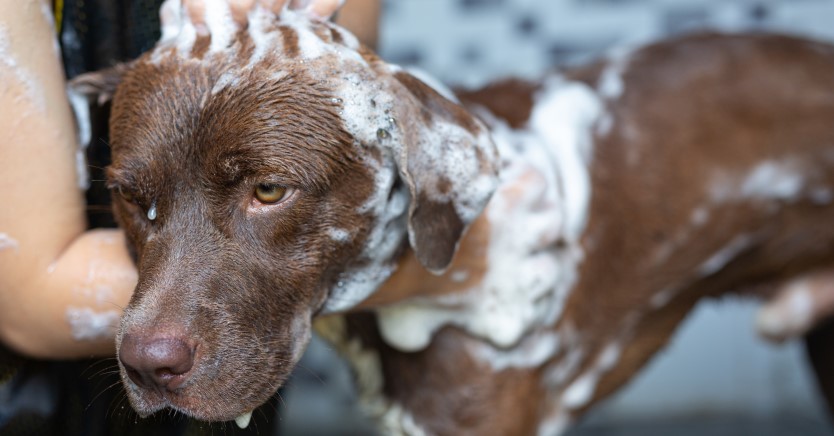Ask Dr. Jenn: How Can I Get Rid of Fleas on My Dog?
My dog contracted fleas. I've washed her with the flea shampoo several times and they keep coming back (I believe because of previously laid eggs). Is there anything I can give her that will get rid of them?

Fleas can be so frustrating! You think you are doing everything right, but they just keep coming back. To understand why, you need to understand the lifecycle of a flea.
The Lifecycle of a Flea
The adult flea is only the tip of the iceberg. We see the adult fleas, but we don’t see the immature flea stages – the eggs, larva, and pupa. A female flea can lay 40-50 eggs a day, half of which are female. You can see how quickly the flea population can explode!
If conditions are right, a flea egg can hatch in two days and a flea larva emerges. Nine days later, the larva becomes a pupa. A pupa is a protective cocoon in which the adult flea develops in as quickly as seven days or stays dormant for up to a year.
Only the adult fleas live on your pet, biting and feeding off her for up to one hundred days. Meanwhile, the eggs, larvae, and pupae are hanging out in your pet’s bed, your carpet and furniture, and the cracks in your floorboards. Once they emerge from their cocoons, the fleas can live for up to seven days in their environment just waiting until your pet walks by. They then jump on your pet, start biting, and begin to lay eggs, starting the whole cycle over again.
How to Get Rid of Fleas for Good
A flea bath will kill all the adult fleas on your dog, but it’s not going to kill the immature stages in your house. What if you are also treating your house with a flea spray or you hire an exterminator? You will kill the eggs and larvae, but the pupae are very hearty. They are resistant to insecticides, freezing, and drying out. And remember, they can survive in the pupae stage for up to a year!
So how do you get a flea infestation under control?
Over the past decade, flea control has dramatically improved. We now have many more weapons in our arsenal beyond flea shampoo, sprays, and collars. Many of the newer flea treatments work for a month or more. They don’t just kill adult fleas, but they also contain Insect Growth Inhibitors, or IGRs. IGRs cause a female flea to lay sterile eggs that will not hatch. With these treatments, you are hitting two stages of the flea’s lifecycle – the adult and the egg. Considering how many eggs just one female can lay, you can understand why the IGR is so important.
Some of these products are prescription only so I advise you to call your veterinarian’s office to discuss what products they feel would work best in your situation. Depending on where you live, some fleas may be more resistant to one product and respond better to another. Also, some dogs are allergic to fleas and may develop a reaction and skin infection. Your veterinarian can check your pet over to see if additional medications are needed.
How Long Does It Take to Kill Fleas?
Even with proper treatment, it can take up to three months to completely resolve a flea infestation. If you’re using a monthly flea treatment, mark your calendar so the treatment isn’t late.
You’ll need to treat all pets in the environment, even if they aren’t showing signs of fleas. This includes cats, dogs, and other pocket pets, such as rabbits, ferrets, and hamsters. Only use a product labeled for the species you are treating. Cats are more sensitive to pesticides than dogs so if you apply a dog product to a cat, the cat can become very sick or start having seizures. If you have pocket pets, ask your veterinarian what product is safe for them.
Make sure you are keeping the environment clean as well. In many cases, you don’t need to flea bomb your house. However, it is important to vacuum daily to remove eggs, larvae, and pupae from the carpet. Make sure you empty the canister and throw away the contents as soon as you finish vacuuming. The fleas can hatch inside the vacuum and crawl out. Bedding can be washed with hot water to kill the eggs and larvae.
Once you have your flea infestation under control, I recommend you continue with regular flea prevention as recommended by your veterinarian. As you have probably learned, it is a lot easier to prevent fleas than it is to treat a flea infestation.
One more thing – fleas can be carriers of tapeworms. To keep your pets healthy, you should give them deworming medication about one month after you find fleas and continue monthly until the flea infestation is resolved.
Ready to start saving money on pet wellness care?
Then take a look at Mint Wellness, the pet wellness plan that provides fast reimbursement on routine pet care. Save on vaccinations, wellness exams, preventatives, dental, and more!
Learn More